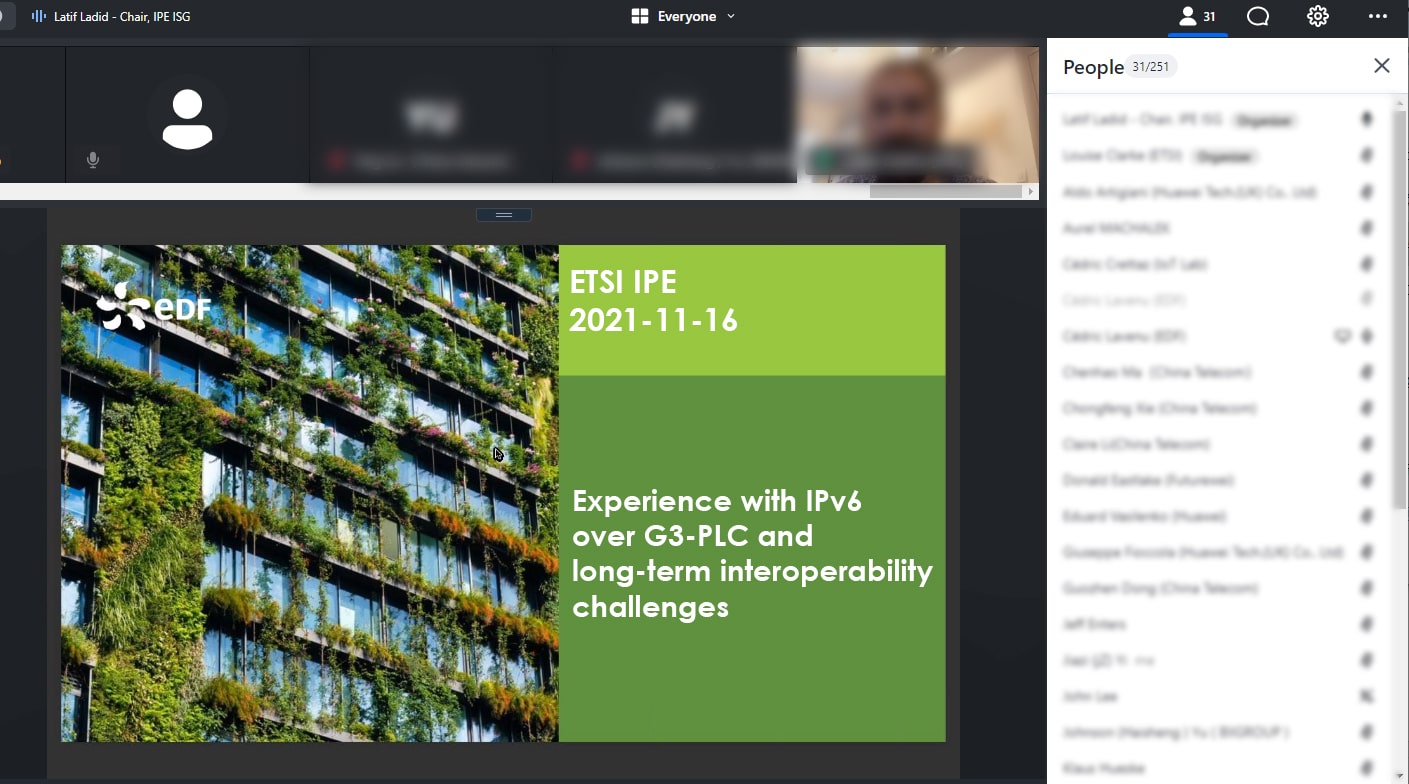On 16 November ETSI ISG IPE held its 11th online Rapporteur call with about 30 participants, including delegates from EDF, Cisco, HPE, Huawei, Verizon, China Telecom attending the meeting.
Cédric Lavenu, Expert Research Engineer at EDF (Electricité de France) and Chair of the G3-PLC Alliance Technical Working Group, shared experience with the deployment of the G3-PLC technology, which is designed to natively support IPv6.
In 2011, French DSO (Distribution System Operator) Enedis started its smart grid project with IPv6-based G3-PLC (Power Line Communication) smart meters, called “Linky”. In late 2021, the Linky deployment is almost complete and consists of nearly 35 million smart meters deployed in the low voltage grid, behind one of the 740.000 medium voltage to low voltage transformer substations. This makes Enedis one of the largest IPv6 operators in the world.

Today, the G3-PLC Alliance estimates that over 80 million IPv6-based G3-PLC products operate in more than 30 countries worldwide. While G3-PLC is one of the leading technologies being used for the deployment of smart meters worldwide, other application use cases also emerge. Besides the smart grid, smart railway stations are a good example.
The G3-PLC protocol stack is defined in ITU-T G.9903. It includes a specific G3-PLC OFDM physical layer, IEEE 802.15.4 data link layer and LOADng as the default mesh-under routing protocol. With IETF 6LowPAN protocol, the stack has the full support of IPv6. More recently, the G3-PLC Alliance has introduced the Hybrid PLC&RF profile, which complements the PLC technology with a secondary SUN FSK radio channel.
One of the main takeaways lies in the long-term interoperability challenges related to the extended lifetime of industrial systems such as smart metering infrastructures (20+ years). Beyond offering a high scalability, the choice of IPv6 contributes to secure G3-PLC deployments as it increases its compatibility with applications and IT infrastructure solutions which may be developed exclusively for IPv6. Yet, although convergence towards IPv6 is the ultimate goal, non-IP and IPv4 legacy systems might be operated in parallel to IPv6 systems over up to tens of years in the industry environments. The resulting technical challenges represent as many topics of interest to the IPv6 community.
Following the presentation from EDF, the rapporteurs discussed the progress of their open work items. Ramirez Medel from Philippine IPv6 Forum & Globe Telecom introduced the outline of the new IPE PoC Framework. The IPE reports and rapporteurs are:
- DGR/IPE-001 IPE Gap Analysis, (Huawei, Eduard Vasilenko) – Published in August 2021
- DGR/IPE-002 IPv6 based Data Centers, Network and Cloud Integration, (China Telecom, Cong LI)
- DGR/IPE-003 Transition to IPv6 Only, (Internet Associates, John Lee)
- DGR/IPE-004 IPv6 based enterprise networking and Industrial Internet, (CISCO, Pascal Thubert)
- DGR/IPE-005 5G Transport and Cloud and IP network Convergence over IPv6/SRv6, (POST Luxembourg, Sebastien Lourdez)
- DGR/IPE-006 IPv6 and Cloud using DataBlockMatrix for Food Supply Chain Tracking and Tracing (Biigroup, Haisehng Yu)
- DGR/IPE-007 IPv6-based 5G for Connected and Automated Mobility (University of Luxembourg, Ion Turcanu)
- RGR/IPE-008 IPv6 Ready Logo Program: IoT & 6TiSCH (Mandat International IoT Lab, Cedric Crettaz)
- DGR/IPE-009 SRv6 based service function chain for value-added service in operator network (China Unicom, Li Jianfei)
- DGR/IPE-010 IPE PoC Framework (Philippine IPv6 Forum & Globe Telecom, Ramirez Medel) – Start of work
Member & participant updates: welcome to Renesas (semiconductor manufacturer) Guizhou University, Axon Partners Group Consulting and CICT (China Information Communication Technologies Group Corporation). ISG IPE now has more than 70 players in a big ISG family from all over the world.